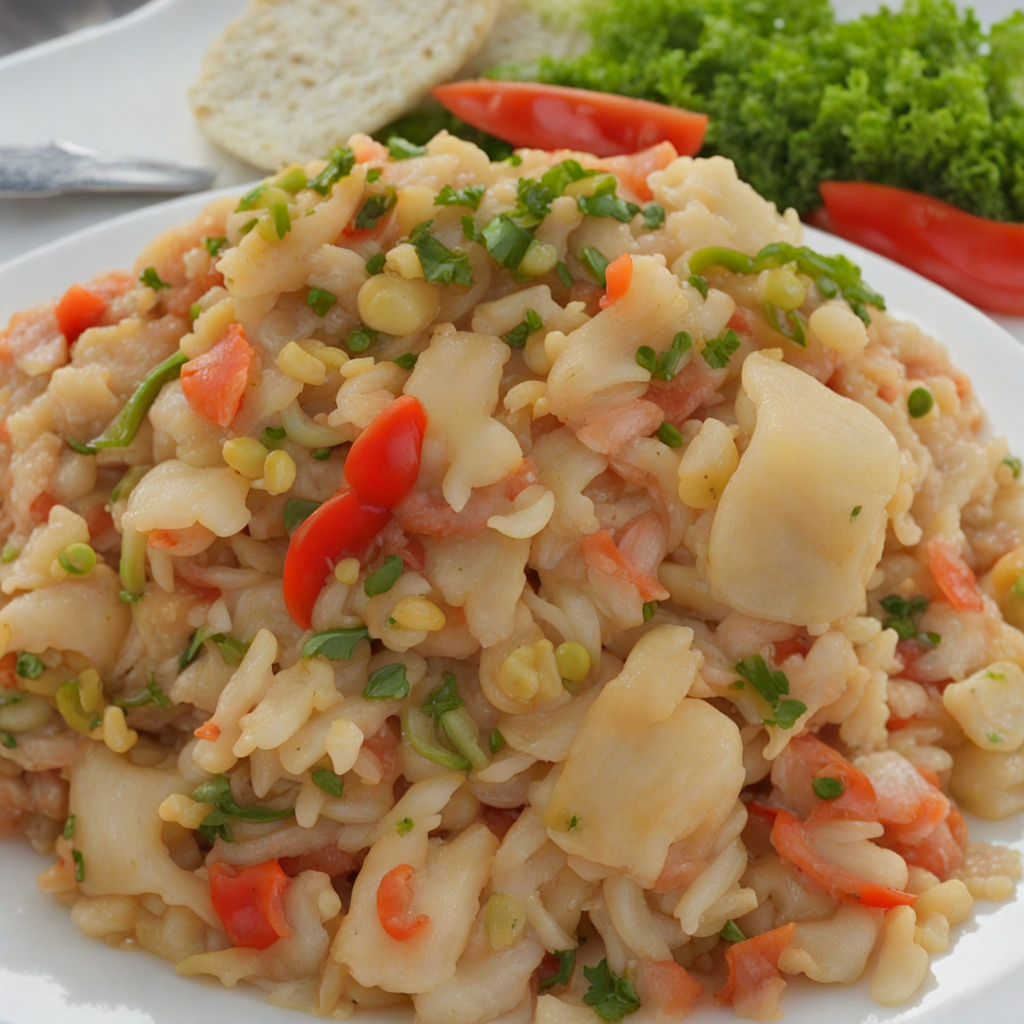Saltfish Buljol
Saltfish Buljol is a vibrant and flavorful dish that encapsulates the essence of Dominican culinary traditions. At its core, it features salted codfish, which is rehydrated and flaked into tender morsels. The fish is the star of the show, bringing a savory, slightly briny taste that pairs beautifully with the freshness of the accompanying ingredients. This dish is often complemented by a medley of diced vegetables, including tomatoes, bell peppers, and onions, creating a colorful and aromatic mixture that tantalizes the senses. What makes Saltfish Buljol truly special is the addition of zesty lime juice and a hint of hot pepper, which elevate the dish with a burst of acidity and heat. The lime juice not only brightens the flavors but also enhances the overall freshness of the dish. This combination of salty, tangy, and spicy notes results in a delightful harmony that dances on the palate, making it an ideal choice for those who enjoy bold and exciting flavors. Typically served as a side dish or appetizer, Saltfish Buljol can be enjoyed with various accompaniments, such as fried plantains or hard-boiled eggs, making it a versatile option for any meal. Its unique blend of textures and flavors offers an inviting experience that reflects the rich cultural heritage of Dominica. Whether you're discovering Caribbean cuisine for the first time or looking to expand your culinary repertoire, Saltfish Buljol promises to be a memorable and delicious adventure.
How It Became This Dish
The History of Saltfish Buljol: A Taste of Dominica's Culinary Heritage Saltfish buljol is a beloved dish from Dominica, a small island nation in the Caribbean known for its rich cultural tapestry and natural beauty. This dish, primarily consisting of saltfish, fresh vegetables, and a zesty mix of spices, encapsulates the island’s culinary heritage, its history of colonization and trade, and its vibrant cultural identity. #### Origins: A Culinary Confluence The roots of saltfish buljol can be traced back to the early colonial periods when European powers, particularly the British and the French, began to settle in the Caribbean. Salted fish was a preservation method used extensively by seafarers and traders, as it allowed for long storage and transport without refrigeration. This method became particularly significant in the Caribbean, where fresh ingredients were not always readily available, especially during long voyages or after storms. The introduction of salted codfish (often referred to simply as "saltfish") coincided with the transatlantic trade routes established during the 17th and 18th centuries. Cod was plentiful in the North Atlantic, and its preservation through salting made it an ideal commodity for trade. As it made its way to the Caribbean, it became a staple ingredient, particularly in island nations like Dominica, where it was incorporated into local cuisine. Buljol itself is thought to have origins in the French word “bouillon,” meaning broth or stew, reflecting the dish's blend of influences from both French and British culinary traditions. The combination of saltfish with fresh vegetables and spices reflects the agricultural bounty of Dominica, where fertile volcanic soil supports a wide range of produce, including tomatoes, onions, and peppers. #### Cultural Significance Saltfish buljol is more than just a dish; it is a representation of Dominica’s cultural identity. The preparation and consumption of buljol often occur during significant communal events, family gatherings, and celebrations, serving as a point of connection among generations. The dish is typically enjoyed as a breakfast or lunch option, often accompanied by fried plantains, boiled green bananas, or bread, making it a filling and nourishing meal. Moreover, buljol illustrates the blend of African, Indigenous, and European culinary practices that characterize Dominican cuisine. After the arrival of enslaved Africans to the Caribbean, they brought with them their own food traditions, which merged with the local and colonial influences to create a unique culinary landscape. Ingredients like onions, peppers, and limes, which are essential to buljol, reflect this fusion. The dish also plays a role in the island’s social fabric. It is often featured during festivals and public events, where local cooks showcase their culinary skills. Competitions held during cultural festivals frequently highlight variations of buljol, drawing attention to the creativity and diversity within Dominican cuisine. #### Development Over Time As Dominica has evolved, so too has the preparation and presentation of saltfish buljol. Traditionally, the dish was made using dried, salted cod that would be soaked, boiled, and flaked before being mixed with chopped vegetables and seasonings. Over the years, the recipe has adapted to include a variety of local ingredients, making it a flexible dish that can change with the seasons and the availability of produce. Modern interpretations of buljol may incorporate various types of fish, reflecting contemporary preferences and sustainable practices. While saltfish remains the classic choice, local fish varieties might be used, depending on the catch of the day. Additionally, the use of local spices and herbs has brought new dimensions to the dish, allowing chefs to experiment with flavors while maintaining the essence of the traditional recipe. In the global context, saltfish buljol has gained recognition, particularly among Caribbean diasporas who yearn for the tastes of home. Restaurants and food festivals in regions with significant Caribbean populations have introduced buljol to a wider audience. As Caribbean cuisine continues to gain popularity worldwide, dishes like saltfish buljol serve as culinary ambassadors, inviting others to experience the rich flavors and history of Dominica. The rise of food tourism in the Caribbean has also played a role in the revitalization of traditional dishes. Visitors to Dominica often seek out authentic culinary experiences, and saltfish buljol provides a perfect opportunity to engage with local culture. Culinary workshops and tours that focus on traditional cooking methods often highlight buljol, allowing participants to learn about its preparation and the cultural narratives that surround it. #### Contemporary Relevance In contemporary Dominica, saltfish buljol remains a staple, with its preparation often being a communal affair. Families gather to prepare large quantities, especially during festive occasions, fostering a sense of togetherness. Additionally, the dish embodies the island's commitment to utilizing local and sustainable ingredients, aligning with a growing global movement towards food sustainability. The impact of climate change on fishing and agriculture has also led to discussions around the ingredients used in buljol. Many Dominicans are becoming more conscious of sourcing local produce and fish to ensure that their culinary traditions remain intact while supporting their local economy. Furthermore, the ongoing documentation of Caribbean food history and the rise of social media have allowed for the sharing of recipes and stories surrounding saltfish buljol. Home cooks and chefs alike are embracing this platform to showcase their family's versions of the dish, fostering a sense of pride in their heritage and inviting a new generation to appreciate the culinary arts. #### Conclusion Saltfish buljol is more than just a meal; it is a flavorful narrative that speaks to Dominica’s history, culture, and identity. From its origins as a means of preservation to its place on the table as a beloved dish, buljol has evolved while retaining its significance. With its ability to adapt to contemporary tastes and its central role in community and family gatherings, saltfish buljol stands as a testament to the resilience and creativity of Dominican culture. As the world continues to embrace the flavors of the Caribbean, saltfish buljol is poised to leave an indelible mark on the culinary landscape, inviting everyone to share in its rich heritage.
You may like
Discover local flavors from Dominica







